前言
在java的庞大体系中,其优秀的工具类(库)的数不胜数,也就是我们平常说的:轮子
如果在我们的日常工作当中,能够将这些轮子用好,可以极大得提升我们的开发效率
下述整理一些日常工作中常用的工具类
Collections
排序
实现升序和降序
List<Integer> list = new ArrayList<>();
list.add(2);
list.add(1);
list.add(3);
Collections.sort(list);//升序
System.out.println(list);// [1, 2, 3]
Collections.reverse(list);//降序
System.out.println(list);// [3, 2, 1]
获取最大或最小值
找出集合中的最大值或者最小值,这时可以使用Collections的max和min方法
List<Integer> list = new ArrayList<>();
list.add(2);
list.add(1);
list.add(3);
Integer max = Collections.max(list);//获取最大值
Integer min = Collections.min(list);//获取最小值
System.out.println(max);// 3
System.out.println(min);// 1
转换线程安全集合
java中的很多集合,比如:ArrayList、LinkedList、HashMap、HashSet等,都是线程不安全的
这些集合在多线程的环境中,添加数据会出现异常
可以用Collections的synchronizedxxx方法,将这些线程不安全的集合,直接转换成线程安全集合
List<Integer> list = new ArrayList<>();
list.add(2);
list.add(1);
list.add(3);
List<Integer> integers = Collections.synchronizedList(list);//将ArrayList转换成线程安全集合
System.out.println(integers);
TIPS:它的底层会创建SynchronizedRandomAccessList或者SynchronizedList类,这两个类的很多方法都会用synchronized加锁
二分查找
binarySearch方法提供了一个非常好用的二分查找功能,只用传入指定集合和需要找到的key即可
List<Integer> list = new ArrayList<>();
list.add(2);
list.add(1);
list.add(3);
int i = Collections.binarySearch(list, 3);//二分查找
System.out.println(i );// 2
转换成不可修改集合
为了防止后续的程序把某个集合的结果修改了,有时候我们需要把某个集合定义成不可修改的,使用Collections的unmodifiablexxx方法就能轻松实现
List<Integer> list = new ArrayList<>();
list.add(2);
list.add(1);
list.add(3);
List<Integer> integers = Collections.unmodifiableList(list);
integers.add(4);
System.out.println(integers);
执行结果:
Exception in thread "main" java.lang.UnsupportedOperationException
at java.util.Collections$UnmodifiableCollection.add(Collections.java:1055)
at com.wind.service.UtilTest.main(UtilTest.java:28)
其他常用方法
上述只列举几个常用场景的轮子,工具类中还有很多其他场景常用的方法,可以根据需要去探索
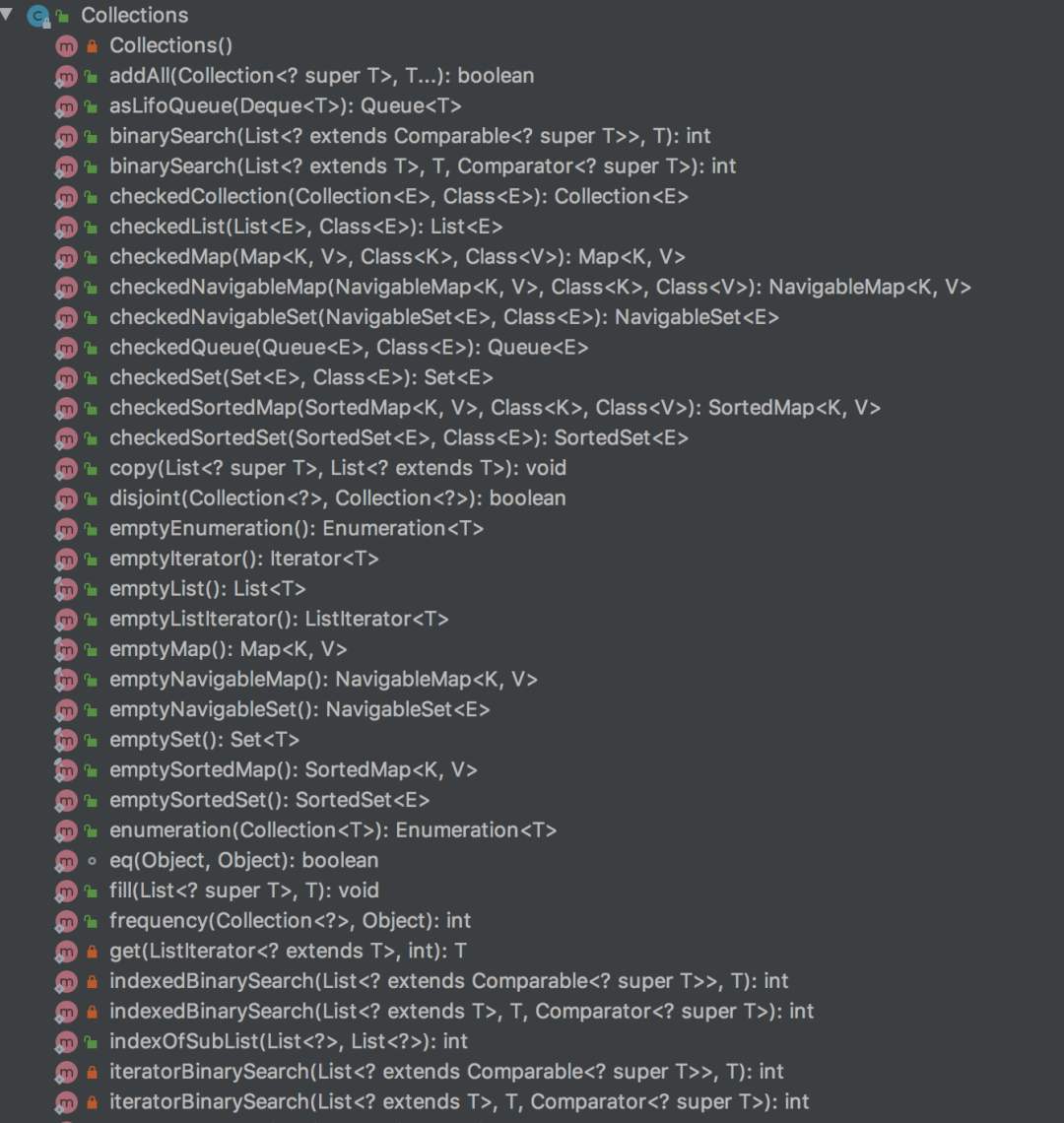
CollectionUtils
- spring的org.springframework.util包下的CollectionUtils
- apache的org.apache.commons.collections包下的CollectionUtils
下面以apache的CollectionUtils工具类为例,介绍一下常用方法
<dependency>
<groupId>org.apache.commons</groupId>
<artifactId>commons-collections4</artifactId>
<version>4.4</version>
</dependency>
集合判空
通过CollectionUtils工具类的isEmpty方法可以轻松判断集合是否为空,isNotEmpty方法判断集合不为空
List<Integer> list = new ArrayList<>();
list.add(2);
list.add(1);
list.add(3);
if (CollectionUtils.isEmpty(list)) {
System.out.println("集合为空");
}
if (CollectionUtils.isNotEmpty(list)) {
System.out.println("集合不为空");
}
对两个集合进行操作
有时候我们需要对已有的两个集合进行操作,比如取交集或者并集等
List<Integer> list = new ArrayList<>();
list.add(2);
list.add(1);
list.add(3);
List<Integer> list2 = new ArrayList<>();
list2.add(2);
list2.add(4);
//获取并集
Collection<Integer> unionList = CollectionUtils.union(list, list2);
System.out.println(unionList);// [1, 2, 3, 4]
//获取交集
Collection<Integer> intersectionList = CollectionUtils.intersection(list, list2);
System.out.println(intersectionList);// [2]
//获取交集的补集
Collection<Integer> disjunctionList = CollectionUtils.disjunction(list, list2);
System.out.println(disjunctionList);// [1, 3, 4]
//获取差集
Collection<Integer> subtractList = CollectionUtils.subtract(list, list2);
System.out.println(subtractList);// [1, 3]
其他常用方法
上述只列举几个常用场景的轮子,工具类中还有很多其他场景常用的方法,可以根据需要去探索

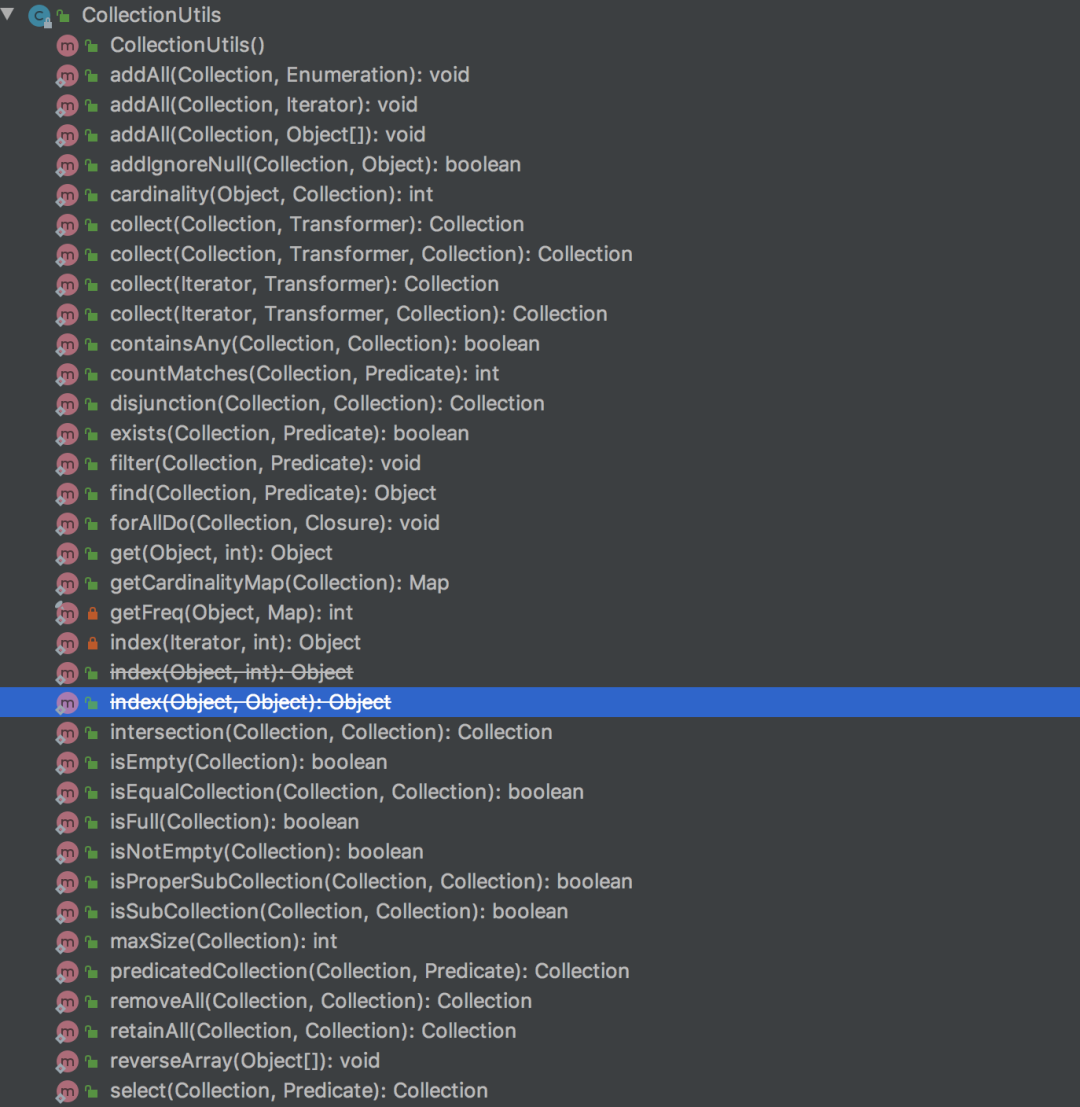
Lists
<dependency>
<groupId>com.google.guava</groupId>
<artifactId>guava</artifactId>
<version>30.1-jre</version>
</dependency>
创建空集合
List<Integer> list = Lists.newArrayList();
笛卡尔积
将两个集合做笛卡尔积,Lists的cartesianProduct方法可以帮你实现
List<Integer> list1 = Lists.newArrayList(1, 2, 3);
List<Integer> list2 = Lists.newArrayList(4,5);
List<List<Integer>> productList = Lists.cartesianProduct(list1,list2);
System.out.println(productList);
执行结果:
[[1, 4], [1, 5], [2, 4], [2, 5], [3, 4], [3, 5]]
分页
一个大集合(5条)按大小为(2)分成若干个3(3页)小集合,可以使用Lists的partition方法
List<Integer> list = Lists.newArrayList(1, 2, 3, 4, 5);
List<List<Integer>> partitionList = Lists.partition(list, 2);
System.out.println(partitionList);
执行结果:
[[1, 2], [3, 4], [5]]
TIPS场景:现在有10000个id,需要调用批量用户查询接口,查出用户数据。但如果你直接查10000个用户,单次接口响应时间可能会非常慢。如果改成分页处理,每次只查1000个用户,异步调用10次接口,就不会有单次接口响应慢的问题
流处理
下述使用Lists的transform方法将小写字母转换成了大写字母
List<String> list = Lists.newArrayList("a","b","c");
List<String> transformList = Lists.transform(list, x -> x.toUpperCase());
System.out.println(transformList);
颠倒顺序
通过Lists的reverse实现颠倒顺序
List<Integer> list = Lists.newArrayList(3, 1, 2);
List<Integer> reverseList = Lists.reverse(list);
System.out.println(reverseList);// [2, 1, 3]
其他常用方法
上述只列举几个常用场景的轮子,工具类中还有很多其他场景常用的方法,可以根据需要去探索
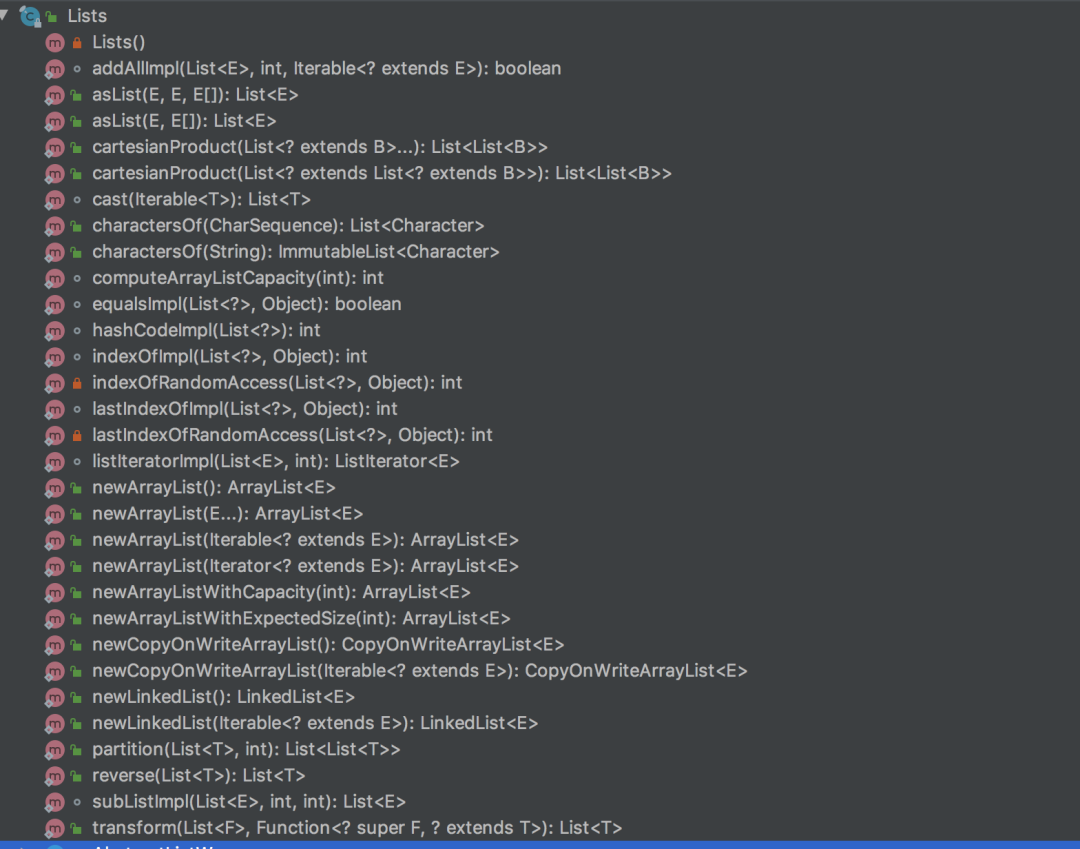
Objects
对象判空
Objects的isNull方法判断对象是否为空,而nonNull方法判断对象是否不为空
Integer integer = new Integer(1);
if (Objects.isNull(integer)) {
System.out.println("对象为空");
}
if (Objects.nonNull(integer)) {
System.out.println("对象不为空");
}
对象为空抛异常
想在对象为空时,抛出空指针异常,可以使用Objects的requireNonNull方法
Integer integer1 = new Integer(128);
Objects.requireNonNull(integer1);
Objects.requireNonNull(integer1, "参数不能为空");
Objects.requireNonNull(integer1, () -> "参数不能为空");
获取对象的hashCode
获取某个对象的hashCode,可以使用Objects的hashCode方法
String str = new String("abc");
System.out.println(Objects.hashCode(str));
其他常用方法
上述只列举几个常用场景的轮子,工具类中还有很多其他场景常用的方法,可以根据需要去探索
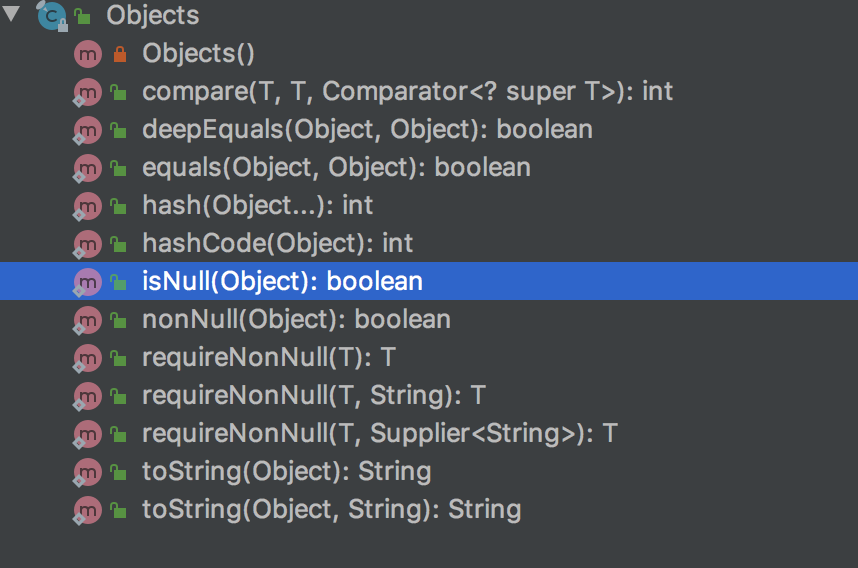
BooleanUtils
判断true/false
判断某个参数的值是true或false,可以直接使用isTrue或isFalse方法
Boolean aBoolean = new Boolean(true);
System.out.println(BooleanUtils.isTrue(aBoolean));
System.out.println(BooleanUtils.isFalse(aBoolean));
判断不为true/不为false
某个参数不为true,即是null或者false。或者判断不为false,即是null或者true
Boolean aBoolean = new Boolean(true);
Boolean aBoolean1 = null;
System.out.println(BooleanUtils.isNotTrue(aBoolean));// false
System.out.println(BooleanUtils.isNotTrue(aBoolean1));// true
System.out.println(BooleanUtils.isNotFalse(aBoolean));// true
System.out.println(BooleanUtils.isNotFalse(aBoolean1));// true
转换数字
将true转换成数字1,false转换成数字0,可以使用toInteger方法
Boolean aBoolean = new Boolean(true);
Boolean aBoolean1 = new Boolean(false);
System.out.println(BooleanUtils.toInteger(aBoolean));// 1
System.out.println(BooleanUtils.toInteger(aBoolean1));// 0
Boolean转换成布尔值
将包装类Boolean对象,转换成原始的boolean对象,可以使用toBoolean方法
Boolean aBoolean = new Boolean(true);
Boolean aBoolean1 = null;
System.out.println(BooleanUtils.toBoolean(aBoolean));
System.out.println(BooleanUtils.toBoolean(aBoolean1));
System.out.println(BooleanUtils.toBooleanDefaultIfNull(aBoolean1, false));
其他常用方法
上述只列举几个常用场景的轮子,工具类中还有很多其他场景常用的方法,可以根据需要去探索
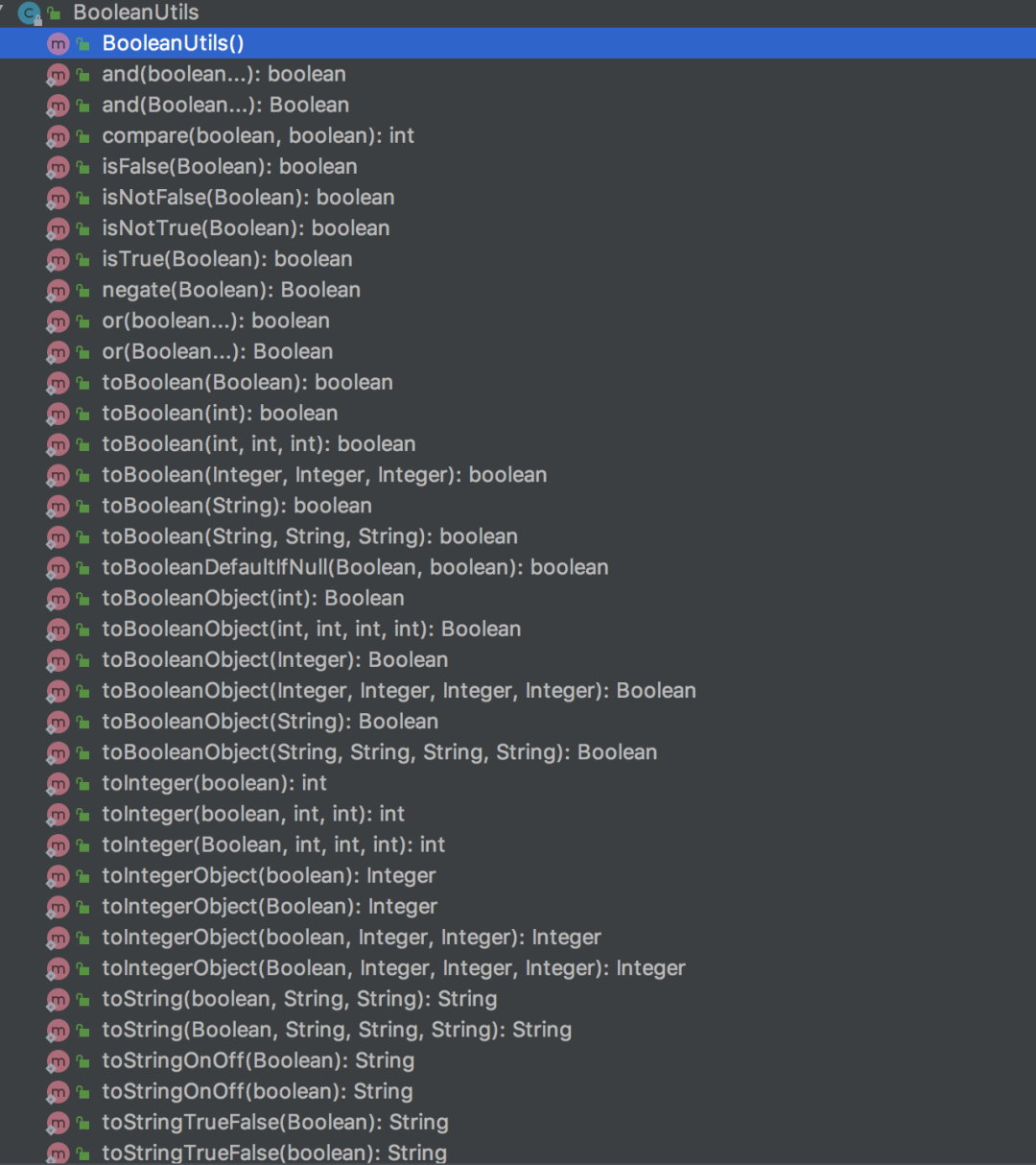
StringUtils
字符串(String)在日常工作中,用得非常非常非常多
在我们的代码中经常需要对字符串判空,截取字符串、转换大小写、分隔字符串、比较字符串、去掉多余空格、拼接字符串、使用正则表达式......
如果只用String类提供的那些方法,我们需要手写大量的额外代码,不然容易出现各种异常
<dependency>
<groupId>org.apache.commons</groupId>
<artifactId>commons-lang3</artifactId>
<version>3.12.0</version>
</dependency>
字符串判空
空字符串有""," ","null"等等,多种情况,StringUtils给提供了多个判空的静态方法,其中的isEmpty、isNotEmpty、isBlank和isNotBlank,这4个判空方法可以根据实际情况使用
String str1 = null;
String str2 = "";
String str3 = " ";
String str4 = "abc";
System.out.println(StringUtils.isEmpty(str1));// true
System.out.println(StringUtils.isEmpty(str2));// true
System.out.println(StringUtils.isEmpty(str3));// false
System.out.println(StringUtils.isEmpty(str4));// false
System.out.println("-----------------------");
System.out.println(StringUtils.isNotEmpty(str1));// false
System.out.println(StringUtils.isNotEmpty(str2));// false
System.out.println(StringUtils.isNotEmpty(str3));// true
System.out.println(StringUtils.isNotEmpty(str4));// true
System.out.println("-----------------------");
System.out.println(StringUtils.isBlank(str1));// true
System.out.println(StringUtils.isBlank(str2));// true
System.out.println(StringUtils.isBlank(str3));// true
System.out.println(StringUtils.isBlank(str4));// false
System.out.println("-----------------------");
System.out.println(StringUtils.isNotBlank(str1));// false
System.out.println(StringUtils.isNotBlank(str2));// false
System.out.println(StringUtils.isNotBlank(str3));// false
System.out.println(StringUtils.isNotBlank(str4));// true
分隔字符串
分隔字符串直接使用String类的split方法,就可能会出现空指针异常,StringUtils不会
String str1 = null;
System.out.println(StringUtils.split(str1,","));
System.out.println(str1.split(","));
执行结果:
null
Exception in thread "main" java.lang.NullPointerException
at com.wind.service.UtilTest.main(UtilTest.java:28)
判断是否纯数字
判断一个字符串它是否为纯数字,可以使用isNumeric方法
String str1 = "280";
String str2 = "280l";
String str3 = "0.28";
System.out.println(StringUtils.isNumeric(str1));// true
System.out.println(StringUtils.isNumeric(str2));// false
System.out.println(StringUtils.isNumeric(str3));// false
将集合拼接成字符串
将某个集合的内容,拼接成一个字符串,然后输出,可以使用join方法
List<String> list = Lists.newArrayList("a", "b", "c");
List<Integer> list2 = Lists.newArrayList(2, 8, 0);
System.out.println(StringUtils.join(list, ","));// a,b,c
System.out.println(StringUtils.join(list2, " "));// 2 8 0
其他常用方法
上述只列举几个常用场景的轮子,工具类中还有很多其他场景常用的方法,可以根据需要去探索
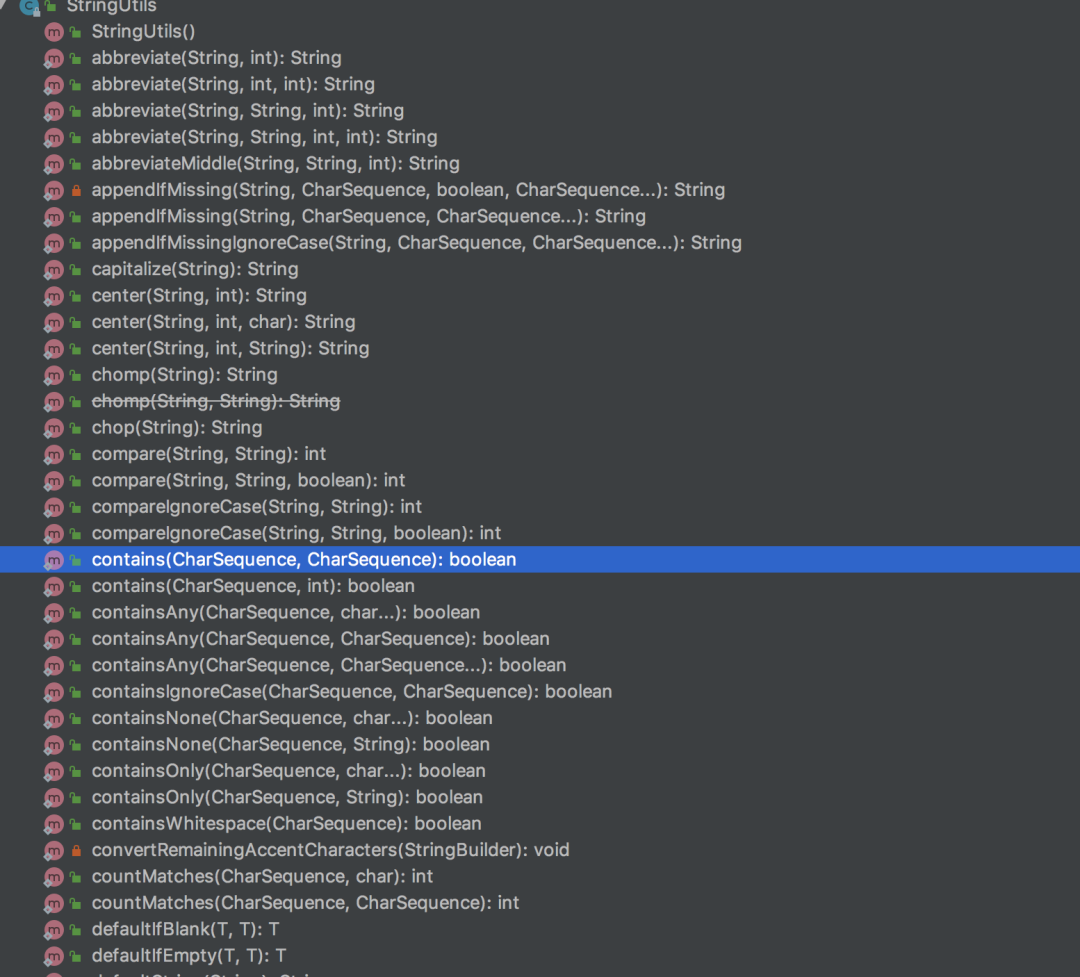
Assert
断言参数是否为空
断言参数是否空,如果不满足条件,则抛出IllegalArgumentException异常
String str = null;
Assert.isNull(str, "str必须为空");
Assert.isNull(str, () -> "str必须为空");
Assert.notNull(str, "str不能为空");
断言集合是否为空
断言集合是否空,如果不满足条件,则抛出IllegalArgumentException异常
List<String> list = null;
Map<String, String> map = null;
Assert.notEmpty(list, "list不能为空");
Assert.notEmpty(list, () -> "list不能为空");
Assert.notEmpty(map, "map不能为空");
断言条件是否为空
断言是否满足某个条件,如果不满足条件,则直接抛异常
List<String> list = null;
Assert.isTrue(CollectionUtils.isNotEmpty(list), "list不能为空");
Assert.isTrue(CollectionUtils.isNotEmpty(list), () -> "list不能为空");
其他常用方法
上述只列举几个常用场景的轮子,工具类中还有很多其他场景常用的方法,可以根据需要去探索
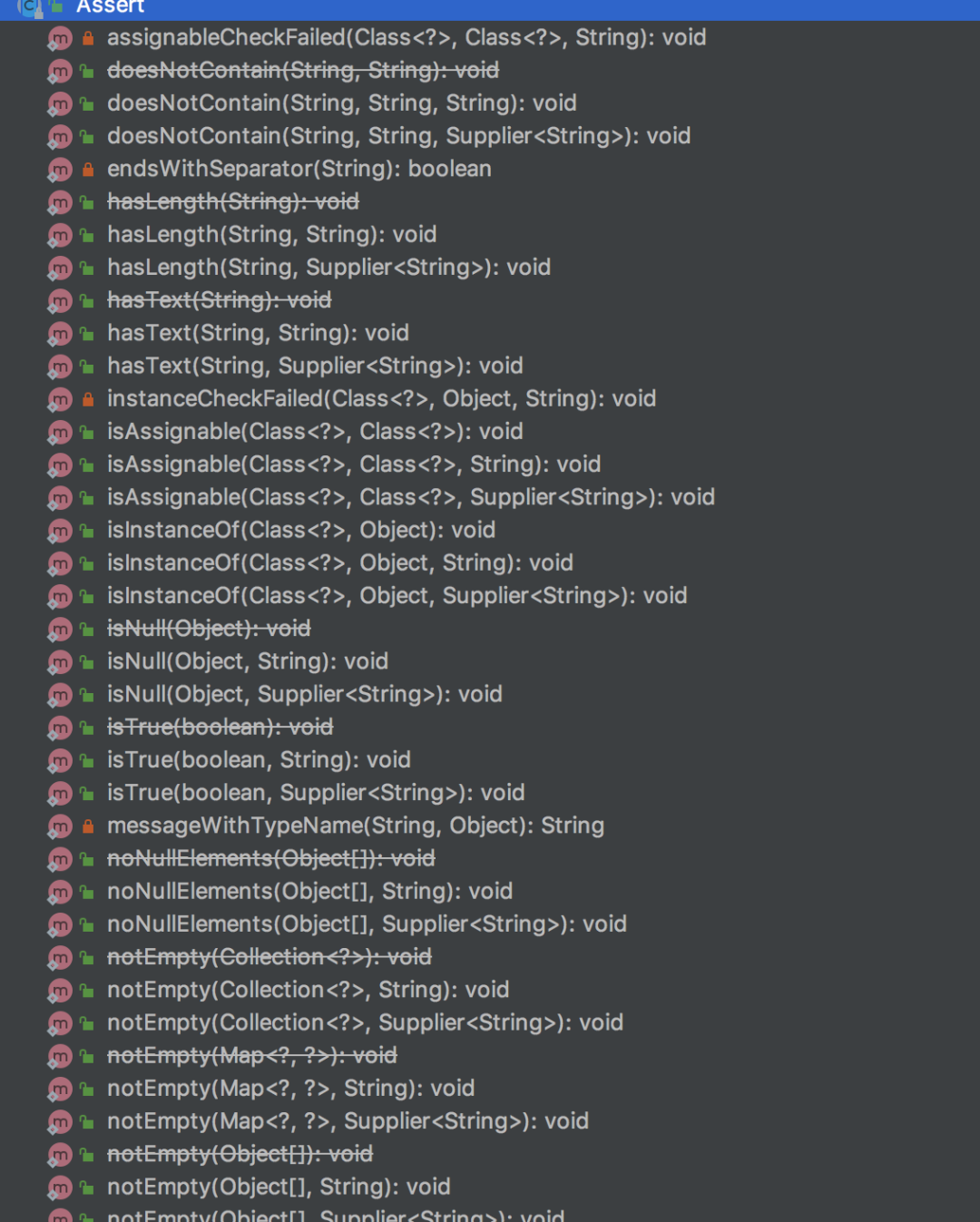
IOUtils
IO流在日常工作中用得比较多,尽管java已经给我们提供了丰富的API,但我们不得不每次读取文件,或者写入文件之后,写一些重复的的代码。手动在finally代码块中关闭流,不然可能会造成内存溢出
读取文件
将某个txt文件中的数据,读取到字符串当中,可以使用IOUtils类的toString方法
String str = IOUtils.toString(new FileInputStream("/temp/test01.txt"), StandardCharsets.UTF_8);
System.out.println(str);
写入文件
将某个字符串的内容,写入到指定文件当中,可以使用IOUtils类的write方法
String str = "Lehman";
IOUtils.write(str, new FileOutputStream("/temp/test02.tx"), StandardCharsets.UTF_8);
文件拷贝
某个文件中的所有内容,都拷贝到另一个文件当中,可以使用IOUtils类的copy方法
IOUtils.copy(new FileInputStream("/temp/test01.txt"), new FileOutputStream("/temp/test02.txt"));
读取文件内容到字节数组
将某个文件中的内容,读取字节数组中,可以使用IOUtils类的toByteArray方法
byte[] bytes = IOUtils.toByteArray(new FileInputStream("/temp/a.txt"));
其他常用方法
上述只列举几个常用场景的轮子,工具类中还有很多其他场景常用的方法,可以根据需要去探索
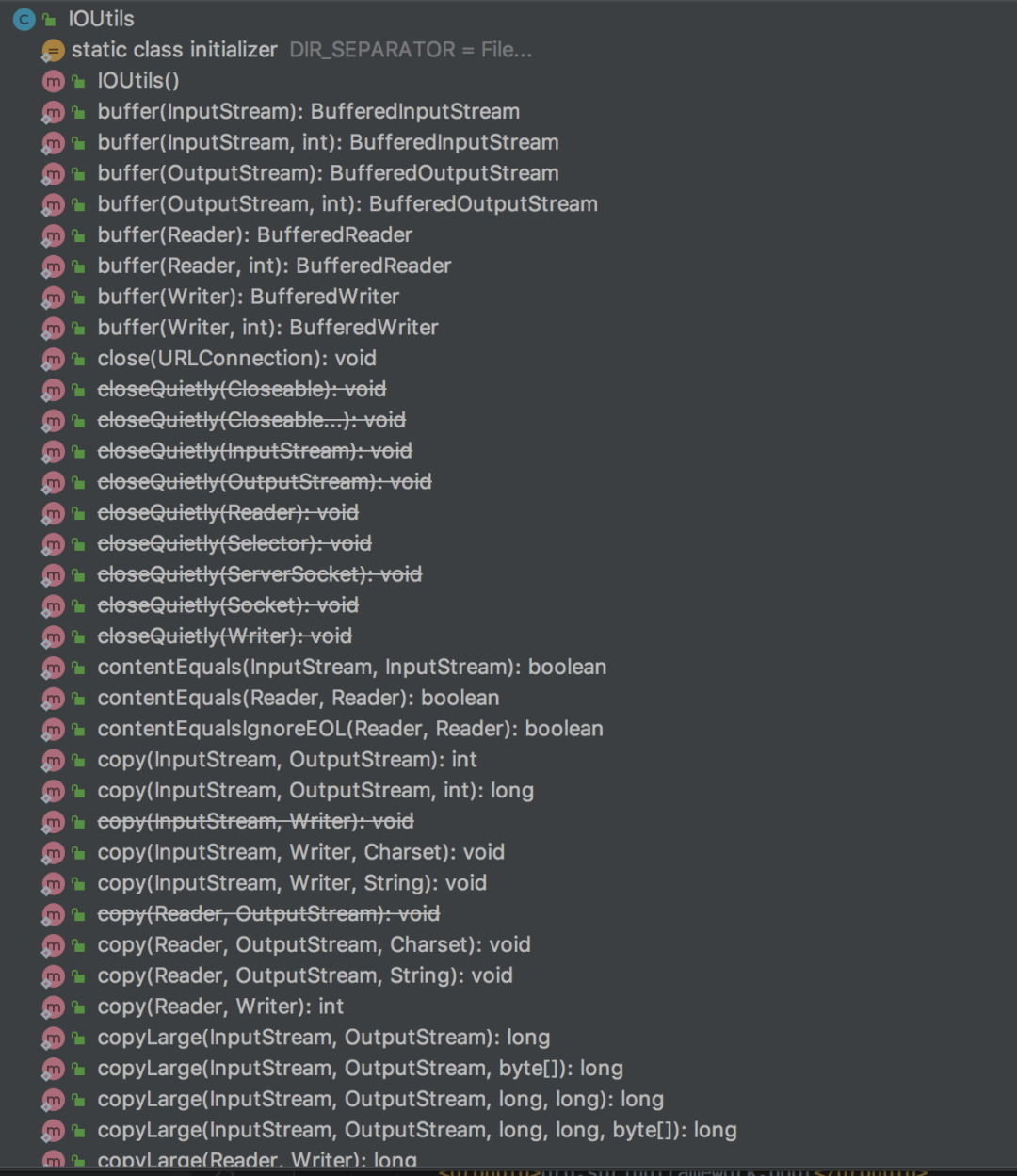
ClassUtils
获取对象的所有接口
获取某个对象的所有接口,可以使用ClassUtils的getAllInterfaces方法
Class<?>[] allInterfaces = ClassUtils.getAllInterfaces(new User());
获取某个类的包名
获取某个类的包名,可以使用ClassUtils的getPackageName方法
String packageName = ClassUtils.getPackageName(User.class);
System.out.println(packageName);
判断某个类是否内部类
判断某个类是否内部类,可以使用ClassUtils的isInnerClass方法
System.out.println(ClassUtils.isInnerClass(User.class));
判断对象是否代理对象
判断对象是否代理对象,可以使用ClassUtils的isCglibProxy方法
System.out.println(ClassUtils.isCglibProxy(new User()));
其他常用方法
上述只列举几个常用场景的轮子,工具类中还有很多其他场景常用的方法,可以根据需要去探索
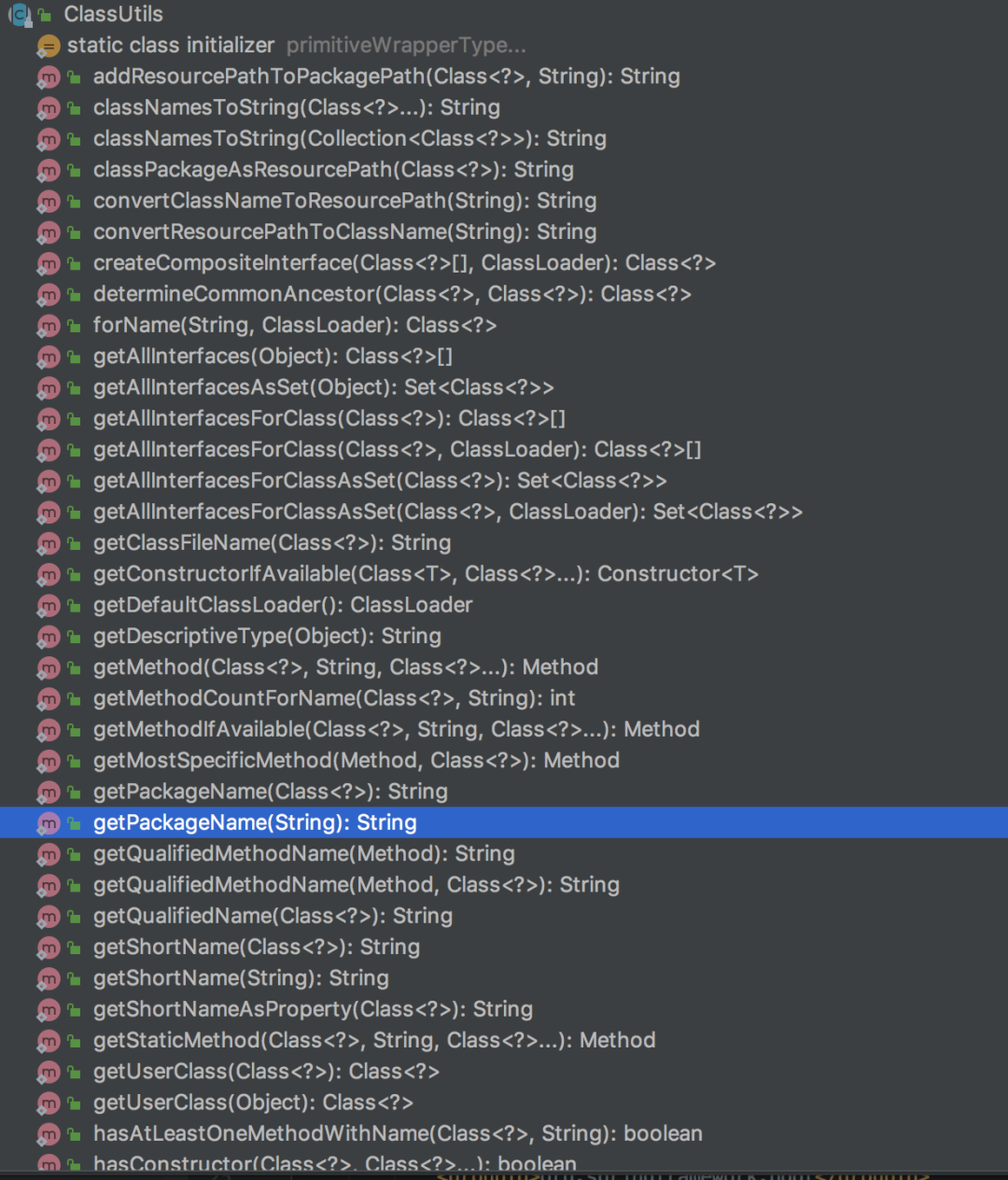
BeanUtils
拷贝对象的属性
把某个对象中的所有属性,都拷贝到另外一个对象中。可以使用BeanUtils的copyProperties方法
User user1 = new User();
user1.setId(1L);
user1.setName("Lehman");
user1.setAddress("上海");
User user2 = new User();
BeanUtils.copyProperties(user1, user2);
System.out.println(user2);
实例化某个类
通过反射实例化一个类的对象,可以使用BeanUtils的instantiateClass方法
User user = BeanUtils.instantiateClass(User.class);
System.out.println(user);
获取指定类的指定方法
获取某个类的指定方法,可以使用BeanUtils的findDeclaredMethod方法
Method declaredMethod = BeanUtils.findDeclaredMethod(User.class, "getId");
System.out.println(declaredMethod.getName());
获取指定方法的参数
获取某个方法的参数,可以使用BeanUtils的findPropertyForMethod方法
Method declaredMethod = BeanUtils.findDeclaredMethod(User.class, "getId");
PropertyDescriptor propertyForMethod = BeanUtils.findPropertyForMethod(declaredMethod);
System.out.println(propertyForMethod.getName());
其他常用方法
上述只列举几个常用场景的轮子,工具类中还有很多其他场景常用的方法,可以根据需要去探索
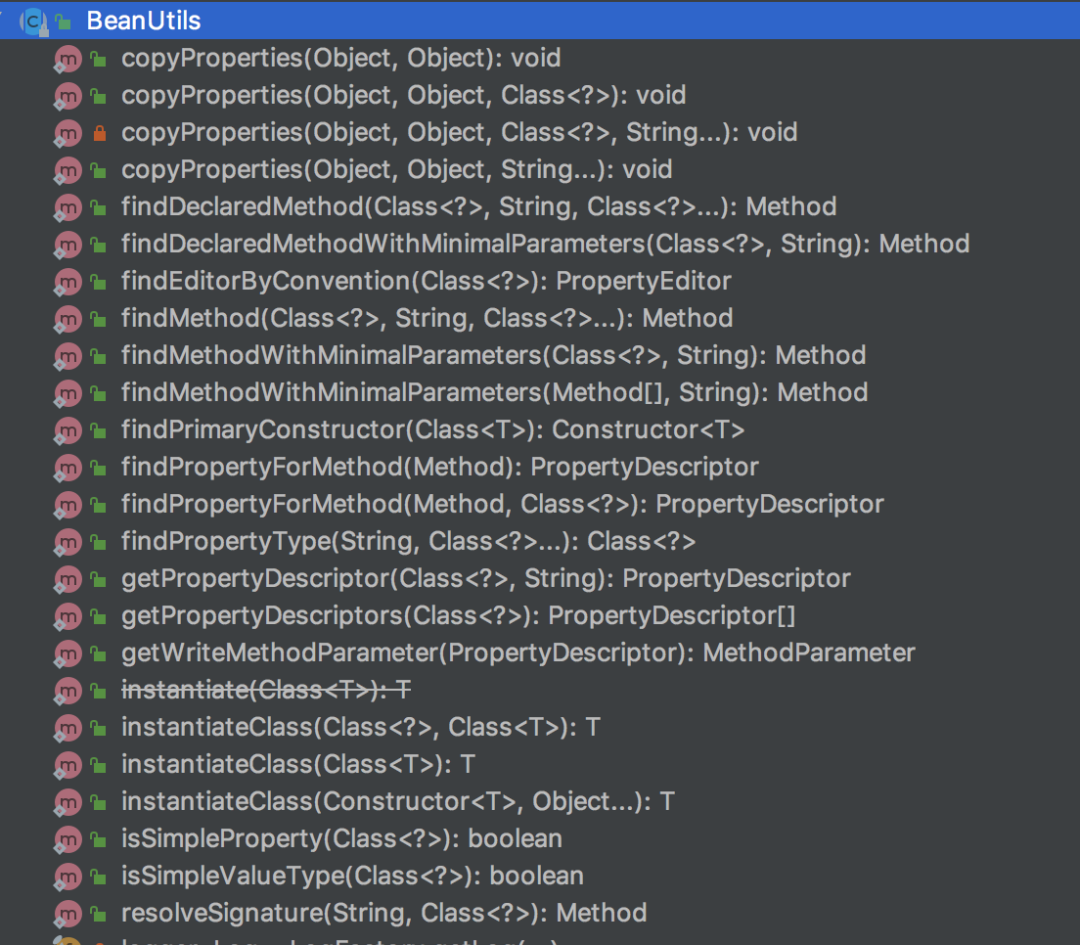
ReflectionUtils
在项目中使用反射功能,如果使用最原始的方法来开发,代码量会非常多,而且很麻烦,它需要处理一大堆异常以及访问权限等问题
获取方法
获取某个类的某个方法,可以使用ReflectionUtils类的findMethod方法
Method method = ReflectionUtils.findMethod(User.class, "getId");
获取字段
获取某个类的某个字段,可以使用ReflectionUtils类的findField方法
Field field = ReflectionUtils.findField(User.class, "id");
执行方法
通过反射调用某个方法,传递参数,可以使用ReflectionUtils类的invokeMethod方法
ReflectionUtils.invokeMethod(method, springContextsUtil.getBean(beanName), param);
判断字段是否常量
判断某个字段是否常量,可以使用ReflectionUtils类的isPublicStaticFinal方法
Field field = ReflectionUtils.findField(User.class, "id");
System.out.println(ReflectionUtils.isPublicStaticFinal(field));
判断是否equals方法
判断某个方法是否equals方法,可以使用ReflectionUtils类的isEqualsMethod方法
Method method = ReflectionUtils.findMethod(User.class, "getId");
System.out.println(ReflectionUtils.isEqualsMethod(method));
其他常用方法
上述只列举几个常用场景的轮子,工具类中还有很多其他场景常用的方法,可以根据需要去探索
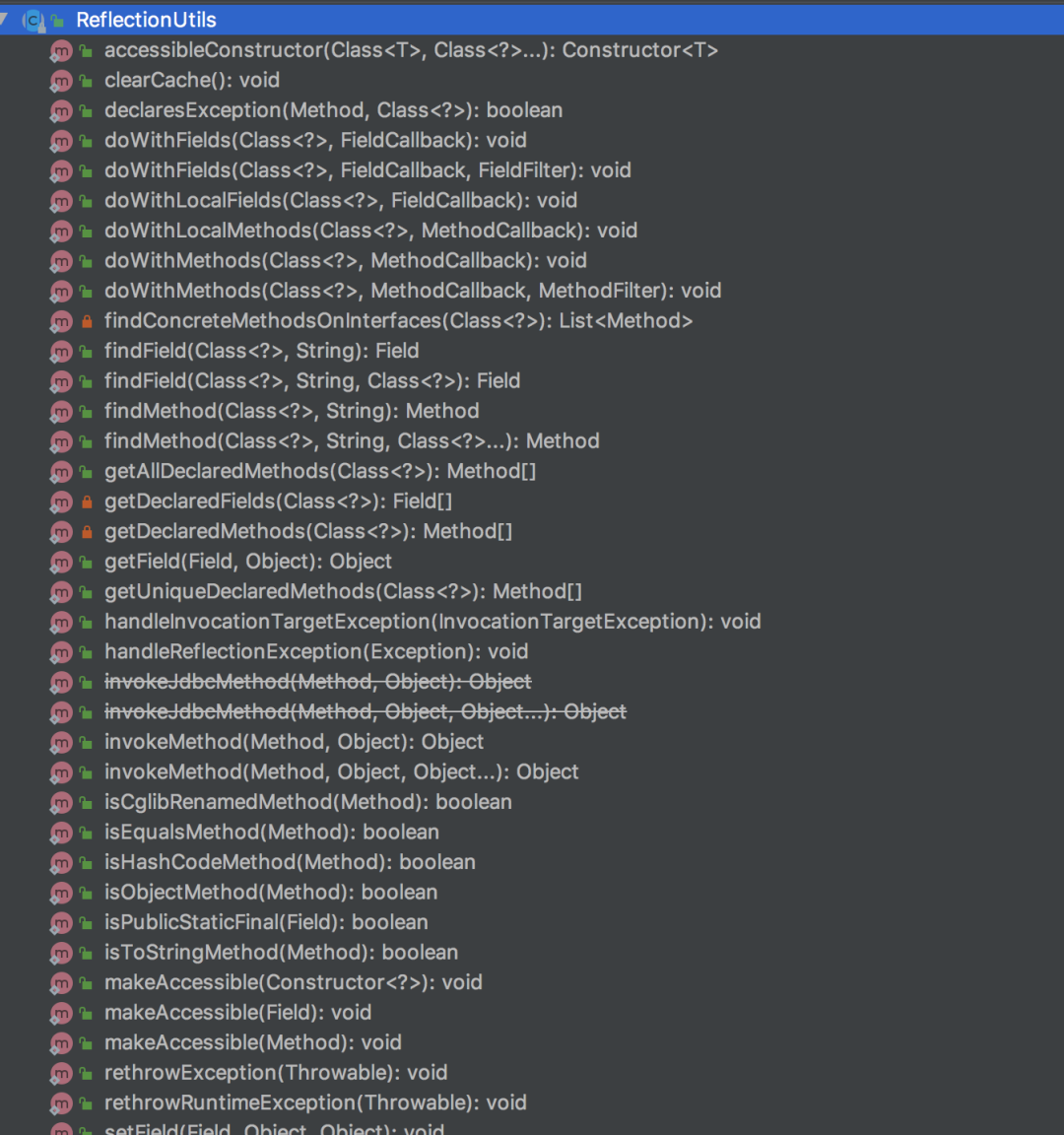
Base64Utils
编码
String str = "Lehman";
String encode = new String(Base64Utils.encode(str.getBytes()));
System.out.println("编码后:" + encode);
解码
try {
// encode 是需要解密的字符
String decode = new String(Base64Utils.decode(encode.getBytes()), "utf8");
System.out.println("后:" + decode);
} catch (UnsupportedEncodingException e) {
e.printStackTrace();
}
其他常用方法
上述只列举几个常用场景的轮子,工具类中还有很多其他场景常用的方法,可以根据需要去探索
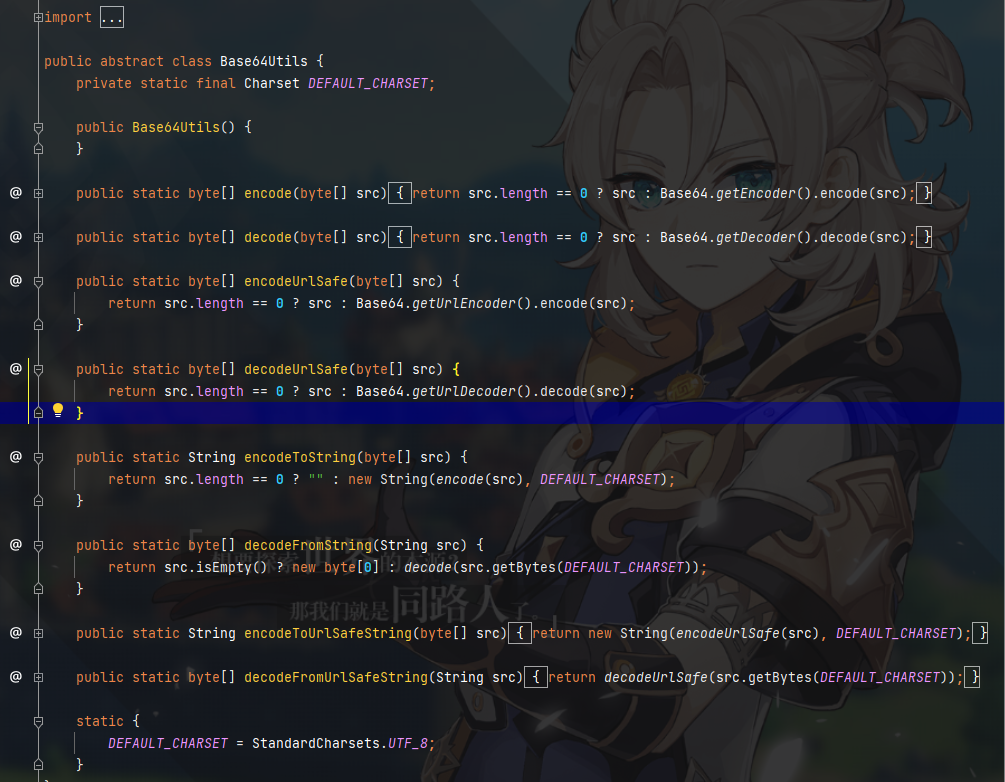
加密/解密
java中还有很多的加密方式,具体可以查看另外一篇文章
其他推荐
- Apache Commons:这是一个非常全面的工具集,包括了如Lang、Collections、IO等模块,用于处理字符串、集合、输入输出等常见任务
- Guava:由Google开发,提供了许多在标准Java集合基础上的增强,如更丰富的集合类型、缓存机制、并发工具等
- Jackson:用于JSON数据处理的高性能库,支持序列化和反序列化
- SLF4J / Logback:用于日志记录,SLF4J是一个日志门面,而Logback是其推荐的实现之一,提供了灵活的日志配置和高效的数据记录
- JUnit / Mockito:用于单元测试,JUnit提供测试框架,而Mockito则帮助创建和验证模拟对象
- Lombok:通过注解减少Java中的冗余代码,自动生成getter、setter、构造函数等
- Hutool:一个轻量级的Java工具类库,提供了对常用功能的封装,如文件读写、网络请求、加密解密等
- RxJava / Reactor:用于响应式编程,提供了异步和事件驱动的API,适用于构建高性能和高响应的应用程序
- AssertJ:提供了一种流畅的断言风格,使得测试代码更加易读和维护
- Spring Framework:虽然更偏向于框架,但其中的Spring Core和Spring Boot提供了大量的工具类,用于简化企业级应用的开发
